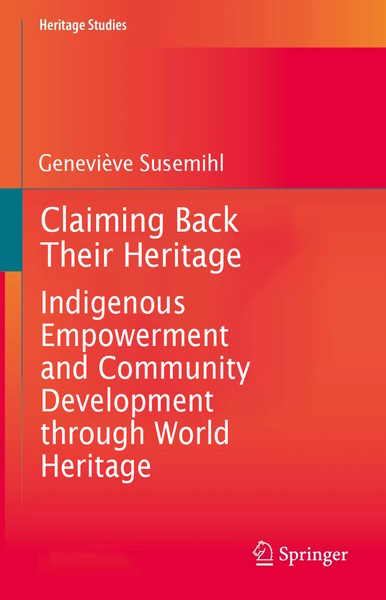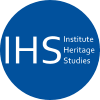
Geneviève Susemihl
This book, published in 2023, provides a unique, in-depth look at three Indigenous World Heritage sites in Canada and their use for Indigenous empowerment and community development. Based on extensive ethnographic field studies and comprehensive narrative interviews, it shows how the three First Nation communities presented in the case studies enforce recognition of their collective rights to preserve their cultural heritage and assert their right to political, economic, cultural, and social self-determination. It also considers the prevailing universalistic discourses around World Heritage and the various ways in which they serve to either reinforce existing oppressive conditions regarding Indigenous communities and voices or provide opportunities to overcome them. The book will be of interest to scholars and students working on social and cultural histories, histories of colonialism, and in heritage and museum studies.
Keywords: World Heritage; Indigenous heritage; heritage management; postcolonialism; heritage discourses; memory; cultural landscape; museum; Indigenous museology; Indigenous empowerment and capacity building; community development; community participation and engagement; Head-Smashed-In Buffalo Jump, SGang Gwaay and Gwaii Haanas; Tr’ondëk-Klondike; visitors’ expectations; tourism; community capacity; Indigenous agency; repatriation; reconciliation; Indigenous knowledges, worldviews and heritage.
Download: Flyer of the Book (PDF).
Published in 2023.
This Book on springer.de: https://link.springer.com/book/10.1007/978-3-031-40063-6.
The complete Series “Heritage Studies Series“ auf springer.de.
TABLE OF CONTENTS
1 Introduction
2 Ideas, Concepts and Uses of Heritage
2.1 Discourses of Heritage
2.2 Uses of Heritage as a Cultural Concept and Process: Identity, Memory, Place
2.3 The Concept of World Heritage: UNESCO and Canada
2.4 Landscape as Heritage
2.5 Heritage and Museums
2.6 The Heritage Industry: Tourism and Management
3 Empowerment and Community Develop-ment through Heritage
3.1 Empowerment, Capacity Building and Community Development
3.2 Community Participation and Engagement
3.3 Building Community Capacity: Indigenous Models and Strategies
3.4 Connections and Constellations: Indigenous Knowledge, Worldviews, Heritage
3.5 Indigenous Rights and Interests: Heritage, Language, Culture
3.6 A Framework for Heritage Use and Community Development
4 Consultation and Communication: Head-Smashed-In Buffalo Jump
4.1 The World Heritage Site of Head-Smashed-In Buffalo Jump
4.2 The Blackfoot and the Buffalo: History and Culture of a People and a Place
4.3 Operation and Ownership of Head-Smashed-In Buffalo Jump
4.4 The Interpretive Centre
4.5 “It’s All Part of the Story”: Blackfoot Voice in Narratives and Storylines
4.6 Looking for “Authentic Indians”: Visitors’ Expectations and Education
4.7 “Claiming the Site as Their Own”: Indigenous Involvement at HSIBJ
4.8 “The Place is Part of Us”: Building Community Capacity for the Future
5 Collaboration and Cooperation: SGang Gwaay and Gwaii Haanas
5.1 The World Heritage Site of SGang Gwaay and Gwaii Haanas
5.2 The Haida of Haida Gwaii: History and Culture of a People and a Place
5.3 Collaboration and Control: A Model for Cooperative Management
5.4 “Celebrating the Living Culture of the Haida”: Representation and Repatriation at the Haida Heritage Centre and the Haida Gwaii Museum
5.5 “They Realize Who We Really Are”: Tourism and Resource Management
5.6 Community Commitment and Communication: Programs and Learning
5.7 “That Which Makes Us Haida”: The Haida Language
5.8 “Equals on All Levels”: A Way into the Future
6 Indigenous Independence, Resilient Relations: The Tr’ondëk-Klondike
6.1 The Proposed World Heritage Site of Tr’ondëk-Klondike
6.2 The Tr’ondëk Hwëch’in: A History of a People and a Place
5.3. Management, Ownership and Protection of the Tr’ondëk-Klondike
6.4 Visitors’ Views and Resource Management: Klondike Tourism and Mining
6.5 Representing and Interpreting the Tr’ondëk-Klondike
6.6 Custodian of a Living Heritage: The Dänojà Zho Cultural Centre
6.7 Community Commitment: Education and Heal-ing through Heritage
6.8 “To Tell A Balanced Perspective”: The Future of Tr’ondëk-Klondike
7 Conclusion
